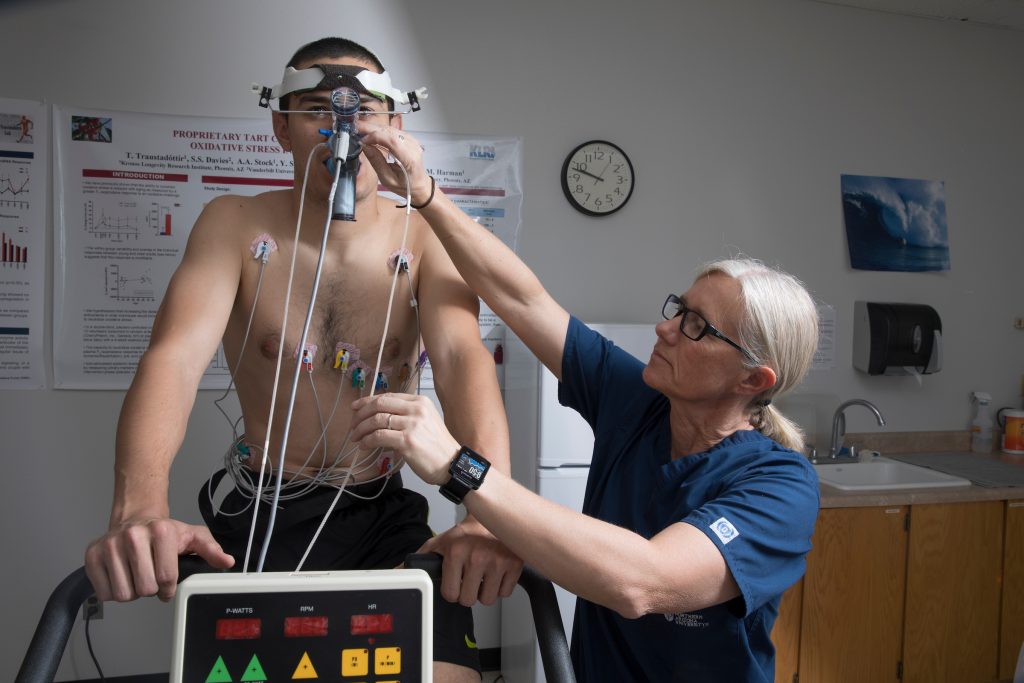By 2020, according to studies published by the U.S. Bureau of the Census, more than 35 percent of the U.S. population will be age 50 and over—and this age group is expected to double by 2050. A Johns Hopkins Bloomberg School of Public Health analysis estimates that more than 70 million Americans ages 50 and older currently suffer from at least one chronic illness.
Investigating ways to protect the body from age-related diseases is a passion for Northern Arizona University physiologist Tinna Traustadóttir, associate professor of biological sciences who has spent 14 years studying exercise physiology and aging. Traustadóttir recently received a $451,000 grant from the National Institutes of Health for a research project titled “Cell Signaling and Resistance to Oxidative Stress: Effects of Aging and Exercise.”
Cell signaling is the means by which cells communicate with each other to coordinate the activities of the body as a whole—including defending against insults and pathogens, growth and the release of hormones. As humans age, cell signaling is disrupted by a chronic increase in oxidative stress, the body’s reaction to the normal utilization of oxygen. This disruption in cell signaling increases the risk for many chronic diseases, including cardiovascular disease, diabetes and hypertension.
Traustadóttir’s research in the field of oxidation-reduction, or “redox” biology, aims to pinpoint the specific age-related changes taking place at the molecular level that increase oxidative stress and determine the amount and type of exercise that can help mitigate the effects of oxidative stress on cell signaling.
“Our lab was the first to show that acute exercise increases an important cell signaling protein called Nrf2 in humans,” said Traustadóttir, who joined NAU in 2011. “The decline in the quality of cell signaling may be a normal part of aging, but we believe it can be modulated by lifestyle, including nutrition and physical activity. That’s something this grant will help us hone in on.”
By better understanding the beneficial effects of exercise on cell signaling, Traustadóttir believes scientists can develop a prescription involving a specific “dose” of exercise that would improve the body’s reaction to oxidative stress. Improved cell signaling could lower the risk for age-related diseases.
She credits NAU’s Office of the Vice President for Research’s Faculty Grant Program and the State of Arizona’s Technology Research Initiative Fund (TRIF) with providing the support needed to do the groundwork that helped her obtain the NIH grant.
“I’m very grateful for the opportunities we had because of the internal funding provided by NAU as well as the funding from TRIF,” said Traustadóttir, who is the project’s principal investigator.
Kiisa Nishikawa, Regents’ Professor of Biology and director of NAU’s Center for Bioengineering Innovation and Derek Sonderegger, assistant professor of mathematics and statistics, are co-investigators on the project. Traustadóttir will also collaborate with other colleagues in biology, chemistry and physiology.
“We know that age is the main risk factor for a lot of diseases,” Traustadóttir said. “Rather than studying a specific disease, however, we are studying how to improve the aging process, which will hopefully delay or prevent those diseases downstream.”
Study participants needed
Traustadóttir and her team will soon begin recruiting participants for an eight-week exercise intervention study. If you are 60 years of age or older, healthy and are interested in participating, send an email to Tinna.Traustadottir@nau.edu to receive more information about the study.



